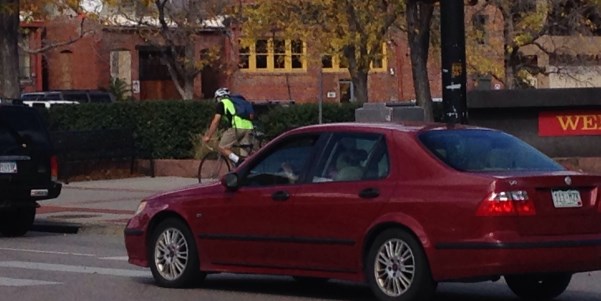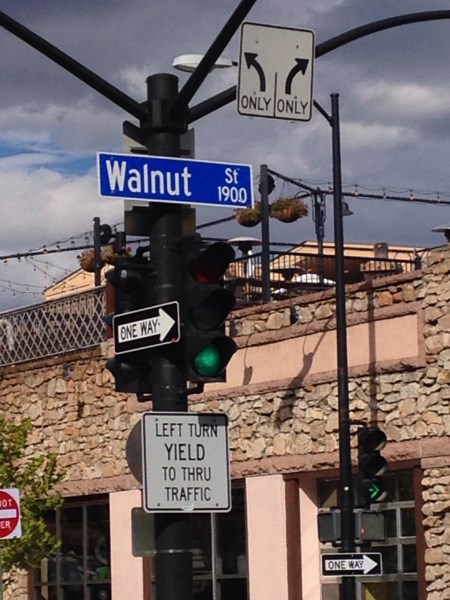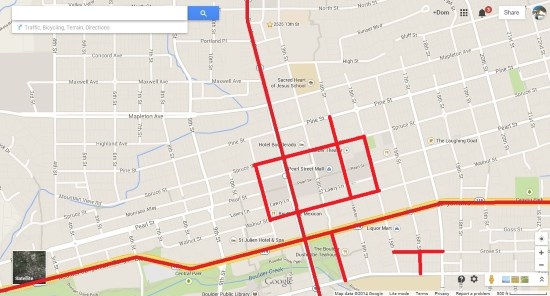What are the factors that induce people to bicycle?
Two of the most important are relatively short travel distances and relatively slow motor vehicle speeds.
Given this, the town center of a community should be one of the most welcoming places to ride a bicycle. And indeed, the town center is very often the most popular place in a city for bicycling in many communities across the U.S.
I have lived in the Mapleton Hill neighborhood in Boulder for five years now. The neighborhood is adjacent to the Boulder town center. Because I am a daily bicycle commuter, I am bicycling in the Boulder town center nearly every day.
Much to my surprise, given how often Boulder is recognized as a bicycle-friendly community at the national level, the Boulder town center is extremely inhospitable to bicycling.
I will discuss the factors that make this so, and end with a few recommendations about how the town center can be made much more safe, popular, and welcoming for bicyclists.
Some Important Obstacles to Bicycling in Boulder
As most all of us here in Boulder readily recognize, high-speed streets with more than three lanes are exceptionally hostile to safe, comfortable bicycling—especially when such streets lack bike lanes. Unfortunately for Boulder, the Colorado Department of Transportation, long ago, constructed two high-speed state highways that cut through the middle of the Boulder town center: Canyon Boulevard and Broadway. Due to the very high “speed differential” between motorists and bicyclists on these two highways (where motorists tend to drive at much higher speeds than bicyclists ride), both of these roads (what Charles Marohn would call “stroads”) are seemingly suicidal, nearly impossible corridors for even the most experienced, brave bicyclists to ride for more than 50 feet or so.
Another unfortunate town center street system decision made in Boulder long ago was to convert a great many two-way street segments into one-way operation. One-way streets create enormous problems for bicyclists. Because they reduce “friction” for motorists, they tend to strongly induce excessive levels of inattentiveness, higher speeds and impatience, and such factors can be a dangerous recipe that often produces unsafe motorist behavior. Healthy town centers depend on slower speeds, retail health, and “agglomeration economies,” and one-way streets substantially undercut each of these needed attributes.
An additional problem with one-way streets—particularly for bicyclists—is that they tend to induce frequent, dangerous “wrong-way” travel, as many people (especially bicyclists) decide it is just too inconvenient to travel blocks out of their way to get to a destination. Instead, many will simply ride the wrong way on a one-way street (at least for a short distance).
Because one-way streets, in recent decades, have very clearly been seen by many of us as detrimental to town center health, a growing number of cities are converting their one-way streets back to two-way operation.
An Inventory of Streets Off-Limits to Bicycling
In my five years of bicycling through the Boulder town center, it has become obvious to me how difficult it is to bicycle in the town center. Recently, I decided to prepare an inventory map of street segments in the Boulder town center that are, in effect, off-limits to bicycling. The attached map shows in red those town center street segments that are inhospitable to bicycling, either because they are high-speed state highways or one-way street segments.
As you can see, a rather large percentage of street mileage in the Boulder town center is off-limits to bicycling. Again, if any place should be comfortable and heavily used by bicyclists, it should be a lower-speed, compact town center. Yet, in a city that regularly is given recognition for being “bike-friendly,” town center bicycling in Boulder is shockingly very difficult and dangerous.
Interested But Concerned
Admirably, Boulder now strives to find ways to encourage the very large number of citizens who are “interested but concerned” about bicycling to become more regular bicyclists. Many experimental designs and policies are now being tested in Boulder as the city strives to create an environment where those citizens will be more likely to ride a bicycle. Indeed, as can be seen in many European cities, town centers tend to be the place where many of the “interested but concerned” bicyclists can be found.
This is not surprising, since town centers tend to offer the slower speeds and shorter travel distances that attract such bicyclists.
Unfortunately, the street segments in red on the map are strongly undercutting this worthy objective of encouraging the “interested but concerned” citizen to ride a bicycle.
A Lesson from Copenhagen
In the 1980s, Copenhagen’s bicycle planners observed that large numbers of bicyclists were using the same major streets that motorists were using. Planners convinced the city to build a high-quality bicycle route on a slower-speed, less-used parallel street.
To the surprise of planners, hardly any bicyclists used the parallel routes. The planners realized that bicyclists wanted to follow the same ‘desire lines’ as motorists—that is, choosing the most direct route. The result was a sea-change in modern bicycle planning, where efforts to direct bicyclists to parallel streets changed to efforts to accommodate bicyclists along the same major streets that motorists preferred.
Copenhagen realized that you can’t tell bicyclists (or pedestrians) where to go. Rather, bicyclists (and pedestrians) will show you where they want to go and you should listen to them and plan accordingly. Unfortunately, Boulder has not yet fully adopted this approach, as can be seen by city efforts to use the parallel 13th and 9th streets as places for bicyclists to ride, instead of Broadway.
Some Suggestions for Making the Boulder Town Center More Bicycle-Friendly
- I am often the first person to point out that it is very difficult, if not impossible, to successfully mix bicyclists with pedestrians on a sidewalk or a path. In general, we should not try to mix bicyclists with pedestrians. However, I believe it was a mistake for Boulder to outlaw bicycling on sidewalks along commercial streets where the sidewalk is not designed or designated for bicycling. On each of the street segments shown in red on the attached map (where bicycling is relatively dangerous), it is incumbent on a community that wishes to promote bicycle travel (especially for those who are “interested but concerned”) to allow slow-speed bicycling on sidewalks. Repealing this counterproductive law would be TEMPORARY, as I would recommend that the prohibition be re-instated when or if the “red segments” shown on my map are redesigned as I recommend below. In addition, during this temporary period where bicyclists would be allowed on sidewalks until the street is re-designed, city rules would require that bicyclists ride responsibly, courteously, and relatively slowly on the sidewalk (preferably, bicyclists would ride at pedestrian speeds). By not allowing bicyclists on sidewalks, the “off-limits” streets create a tremendous amount of inconvenience for bicyclists, as it can mean that the bicyclist must ride one to three blocks out of her or his way to reach a destination.
- Town center health depends on slower speeds, agglomeration economies, and human-scale design. Canyon Boulevard and Broadway, as high-speed state highways, dramatically undermine these necessary attributes and make bicycling a dangerous, impractical form of travel on those corridors. A low-cost, effective treatment for improving the health, safety, aesthetics, and pleasure of the Boulder town center is to re-purpose each of these highways to be three-lane streets. Doing this would slow motor vehicle speeds to speeds more conducive to both bicycling and a healthy town center, and would create needed space for such beneficial treatments as on-street parking and bike lanes.
- Boulder should join the growing revolution in which cities throughout the nation are converting their one-way streets back to two-way operation. Doing so is a quick, effective, low-cost way to dramatically improve town center health, comfort, and safety. Motorists would drive more slowly, more attentively, and more patiently.
- Intersection controls should convenience bicyclists, not motorists—particularly in the town center. Stop lights and stop signs, even in relatively bicycle-friendly Boulder, are surprisingly inconvenient for bicycling. I have noticed that signal lights in the town center are timed for motorist speeds. In a community seeking to promote transit and bicycling, signal lights should rather be timed for buses and bicyclists. In addition, Idaho has revised its state laws so that bicyclists are allowed to treat red signal lights as stop signs, and stop signs as yield signs. Doing this would make bicycling much more advantageous (an important way to encourage more bicycling). Boulder should seek state authorization to apply the Idaho law here (if not statewide).
In sum, Boulder’s town center is shockingly off-limits to bicycling. Fortunately, there are ways for the city to correct that—particularly as a way to encourage the large number of “interested but concerned” citizens to become regular bicyclists, and to substantially grow the overall number of bicyclists in Boulder.







